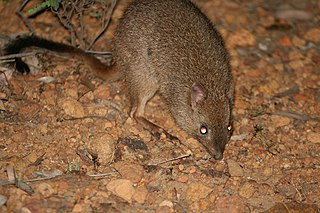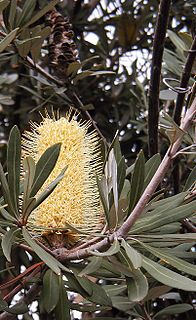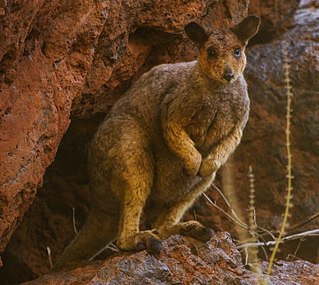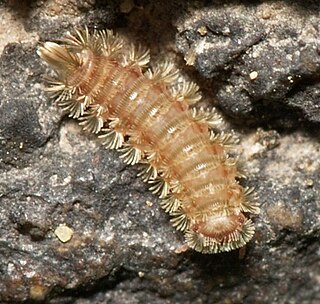
The brush-tailed rock-wallaby or small-eared rock-wallaby is a kind of wallaby, one of several rock-wallabies in the genus Petrogale. It inhabits rock piles and cliff lines along the Great Dividing Range from about 100 km north-west of Brisbane to northern Victoria, in vegetation ranging from rainforest to dry sclerophyl forests. Populations have declined seriously in the south and west of its range, but it remains locally common in northern New South Wales and southern Queensland. However, due to the large bushfire event currently occurring in South-East Australia around 70% of all the wallaby's habitat has been lost as of January 2020.

The black-tufted marmoset, also known as Mico-estrela in Portuguese, is a species of New World monkey that lives primarily in the Neo-tropical gallery forests of the Brazilian Central Plateau. It ranges from Bahia to Paraná, and as far inland as Goiás, between 14 and 25 degrees south of the equator, and can commonly be seen in the City of Rio de Janeiro where it was introduced. This marmoset typically resides in rainforests, living an arboreal life high in the trees, but below the canopy. They are only rarely spotted near the ground.

The woylie or brush-tailed bettong is an extremely rare, small marsupial, belonging to the genus Bettongia, that is endemic to Australia. There are two subspecies: B. p. ogilbyi, and the now extinct B. p. penicillata.

The yellow mongoose, sometimes referred to as the red meerkat, is a member of the mongoose family. It averages about 1 lb (1/2 kg) in weight and about 20 in (500 mm) in length. It lives in open country, from semi-desert scrubland to grasslands in Angola, Botswana, South Africa, Namibia, and Zimbabwe.

The white-plumed honeyeater is a small passerine bird endemic to Australia. White-plumed honeyeaters are common around water and are often seen in backyards and suburbs with vegetation cover.

Flower chafers are a group of scarab beetles, comprising the subfamily Cetoniinae. Many species are diurnal and visit flowers for pollen and nectar, or to browse on the petals. Some species also feed on fruit. The group is also called fruit and flower chafers, flower beetles and flower scarabs. There are around 4,000 species, many of them still undescribed.

Banksia conferta, commonly known as the glasshouse banksia, is a species of shrub that is endemic to eastern Australia. It has rough, bark on the trunk, elliptic to egg-shaped leaves arranged in whorls, crowded yellow flowers in a cylindrical spike later forming a relatively large number of follicles.

Bursera is a genus with about 100 described species of flowering shrubs and trees varying in size up to 25 m (82 ft) high. It is the type genus for Burseraceae. The trees are native to the Americas, from the southern United States south through to northern Argentina, in tropical and warm temperate forest habitats. It is named after the 17th-century Danish botanist Joachim Burser.

Banksia ser. Salicinae is a valid botanic name for a series of Banksia. First published by Carl Meissner in 1856, the name has had three circumscriptions.

The rock-wallabies are the wallabies of the genus Petrogale.

The genus Banksia L.f. (Proteaceae) is a 1981 monograph by Alex George on the taxonomy of the plant genus Banksia. Published by the Western Australian Herbarium as Nuytsia3(3), it presented George's taxonomic arrangement of Banksia, the first major taxonomic revision of the genus since George Bentham published his arrangement in Flora Australiensis in 1870.

Banksia penicillata is a species of shrub that is endemic to a restricted area of New South Wales. It has smooth bark, serrated, elliptic to egg-shaped leaves, green to bluish flower buds, later yellow flowers in a cylindrical spike, and later still, up to one hundred narrow elliptical follicles in each spike, surrounded by the remains of the flowers.

Bettongs, species of the genus Bettongia, are potoroine marsupials once common in Australia. They are important ecological engineers displaced during the colonisation of the continent, and are vulnerable to threatening factors such as altered fire regimes, land clearing, pastoralism and introduced predatory species such as the fox and cat.
Kevin Thiele and Pauline Ladiges taxonomic arrangement of Banksia, published in 1996, was a novel taxonomic arrangement that was intended to align the taxonomy of Banksia more closely with the phylogeny that they had inferred from their cladistic analysis of the genus. It replaced Alex George's 1981 arrangement, but most aspects were not accepted by George, and it was soon replaced by a 1999 revision of George's arrangement. However some herbaria have continued to follow Thiele and Ladiges on some points.

Alex George's taxonomic arrangement of Banksia was the first modern-day arrangement for that genus. First published in 1981 in the classic monograph The genus Banksia L.f. (Proteaceae), it superseded the arrangement of George Bentham, which had stood for over a hundred years. It was overturned in 1996 by Kevin Thiele and Pauline Ladiges, but restored by George in 1999. A recent publication by Austin Mast and Kevin Thiele suggests that it will soon be overturned again.

The grey-headed tanager is a widely distributed species of small Neotropical bird in the tanager family Thraupidae. It is the only member of the genus Eucometis.
Erotic target location error (ETLE) is a hypothesized paraphilia defined by having a sexual preference or strong sexual interest in features that are somewhere other than on one's sexual partners.

Beroe, commonly known as the cigar comb jellies, is a genus of comb jellies in the family Beroidae.

Polyxenida is an order of millipedes readily distinguished by a unique body plan consisting of a soft, non-calcified body ornamented with tufts of bristles – traits that have inspired the common names "bristly millipedes" or "pincushion millipedes". There are at least 86 species in four families worldwide, and are the only living members of the subclass Penicillata.

Coilodera is a genus of beetles belonging to the family Scarabaeidae, subfamily Cetoniinae.

















